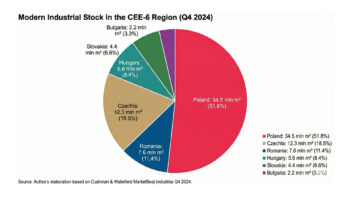While AI agents are increasingly boldly making their way into sales teams, their greatest value is in collaborating with, rather than replacing, humans. In an era of LLMs and automation, it appears that the best results are achieved by those who can build a duo: human + machine.
The new wave: AI agents on sale
As companies become increasingly bold in implementing generative AI, agents supported by large-scale language models (LLMs) are beginning to take on a much more challenging role than classic voice assistants or chatbots. They are no longer just a tool to quickly generate content or provide answers – they are evolving into ‘executive entities’ capable of planning and executing sales tasks themselves.
From the perspective of sales organisations, the change is fundamental. The traditional model: sales person, CRM, pipeline and quarterly targets, is gaining a new dimension, where an AI agent can take over the entire operational layer: analyse historical data, qualify leads, initiate customer contact, conduct follow-ups and even recommend a communication strategy – all with minimal human input. It doesn’t just respond, it thinks within a set objective.
In contrast to classic AI solutions, which operated on the basis of rules and predefined workflows, AI agents operate with greater flexibility and contextual understanding. This means that they are able to adapt actions to a specific situation: a different tone of communication when talking to a customer from the financial industry, a different argumentation when dealing with a SaaS product for a startup.
Gartner describes them as tools that are ready for “autonomous task execution” – which in practice can mean that the agent will decide for itself which leads require immediate action, generate a personalised message and send it at the right moment, without human intervention. This type of decision-making means that some companies are starting to see agents not as an extension of the team, but as a new organisational component of it.
Some companies are beginning to see agents not as an extension of the team, but as a new organisational component of it.
The speed of deployment of such solutions is also not insignificant. With open APIs for language models and a growing number of integration tools, companies can connect AI agents to their existing sales infrastructure with relative ease. As a result, many are already testing not only chatbots, but also autonomous processes that run in the background: searching databases, analysing sales opportunities, suggesting next steps in the funnel.
All this sounds promising – but it also raises questions about control, data quality and the limits of autonomy. Because although AI agents are gaining in importance, this does not mean that the sales department can abandon the human factor. On the contrary – in the next stages, their role as human partners will prove crucial.
The limits of possibility: what AI can’t do yet
Despite the rapid growth of LLM-based AI agents, their increasing presence in sales departments does not mean that they can be entrusted with all responsibility for the customer acquisition and retention process. On the contrary, it is in the most strategic areas, requiring intuition, empathy and relationship-building skills, that the technology still remains a supporting tool rather than a decision-maker in its own right.
AI agents can qualify leads, initiate contact and even suggest follow-ups. But they do not ‘read between the lines’. They won’t understand why a customer changed tone in a second email, why they suddenly stopped writing back despite their earlier interest, or how much a customer’s internal politics affect the speed of a purchase decision. These nuances still require experience, intuition and the ability to assess context – competencies that LLMs simply do not possess.
AI agents do not read between the lines.
Another limitation is the lack of negotiating ability – not in an operational sense (AI can generate an alternative proposal), but in a psychological sense. An effective sales person knows when to be silent, how to exploit silence, when to go beyond the standard offer to keep the customer at the conversation table. For AI, it’s still a black box – models can analyse historical data, but they don’t understand the social game that is enterprise-level selling.
Compliance and accountability remain even more challenging. AI agents may propose actions that, while logical in an algorithmic sense, may not fit within a company’s sales methodology, industry regulations or simply good practice. This is why Gartner emphasises the importance of validating and regularly evaluating AI performance before these actions are implemented in a real-world process.
Paradoxically, therefore, the more autonomous the AI agent, the greater the risk of incompatibility with actual business needs. It is not only the quality of the data on which the model works that becomes crucial, but also the degree of operational maturity of the organisation – which determines whether the agent will be a support or ballast.
All this leads to one conclusion: sales is not just about automating steps in the funnel. It is about people, decisions and relationships – and here AI, at least for now, remains in the background.
Greatest potential: relief, not elimination
The real value of AI agents in sales is not in replacing people, but in redefining what sales teams do. Contrary to the narratives of full autonomy that dominated some of the conference presentations, the day-to-day practice of implementations shows otherwise: the best results are achieved by those companies that use AI not to take over sales processes, but to offload and organise them.
In a typical sales organisation, salespeople spend a surprisingly large amount of time on administrative tasks – updating CRM, selecting leads, preparing initial analysis or writing emails. It is this segment of tasks that AI agents can handle with the greatest efficiency. With their ability to understand context, process data in real time and generate tasks without prompting each time, they become the team’s natural ‘auxiliary processor’.
Gartner’s data shows that AI agents can significantly shorten the sales cycle by speeding up the most time-consuming stages: lead qualification, follow-up, preparation of personalised content and analytics. In practice, this means fewer hours spent on manual work and more space for real sales activities – talking to customers, creating strategies and closing deals.
Companies that treat AI agents as ‘copilots’ rather than autonomous salespeople see a marked increase in productivity. However, the key is to ‘glue’ this collaboration properly. It is not plug-and-play. For an agent to work effectively, it needs to be fed with good quality data, operate within a clearly defined process framework and be part of a larger system that understands how and when to turn on automation.
Counterintuitively, this approach is not only more realistic, but also much quicker to implement. Instead of rebuilding the entire sales process around the technology, companies can integrate AI in stages – where it brings the most value and does not require a fundamental change in organisational culture. It is in this modularity and flexibility that today’s potential for AI agents lies.
Therefore, instead of asking “will AI replace salespeople?”, a different question is more pertinent: “how much more efficient are we able to make them if they stop wasting time on things AI will do faster?”. This is where technology is proving to be most transformative.
Human-in-the-loop: the key to successful implementations
The biggest mistake that companies deploying AI agents to sales teams can make is to assume that the technology will manage itself. In reality, even the most advanced language models will not reach their full potential without the active participation of people – not just as users, but as architects, mentors and process controllers. It is the human-in-the-loop concept that is becoming the foundation of successful implementations today.
From Gartner’s perspective, three elements are key: transparency, validation and alignment with existing sales methodologies. AI agents must be trained on data from specific organisations, taking into account their sales language, go-to-market strategies and industry regulations. Otherwise – even if the model works technically correctly – its recommendations may be misguided, inconsistent with procedures or simply inadequate to the realities of the customer.
This is why the role of sales teams becomes so important, not only as beneficiaries but also as partners in implementation. Companies that involve their salespeople in the process of coaching the models, testing their recommendations and building decision paths achieve noticeably better results. On the one hand, they increase the relevance of AI activities; on the other, they reduce internal resistance and build trust in the technology.
Trust, moreover, is one of the biggest challenges. Many salespeople, especially those with relational sales experience, approach AI with caution – treating it more as a control tool than a support tool. This is understandable, especially in organisations that have previously implemented automation mainly to reduce costs. Therefore, a reformulation of the narrative becomes necessary: AI as a support, not a supervisor; a tool that enhances efficiency, not takes away autonomy.
Validation mechanisms are also needed – not as part of model control, but as a continuous learning process for the organisation. Companies that build a feedback loop between humans and AI can not only better manage the quality of recommendations, but also react faster to market changes by updating the model’s knowledge with new data and contexts.
In this sense, the most advanced AI agent implementations today resemble team operations rather than autonomous technology implementations. Effectiveness does not depend on the ‘power of the model’, but on how well it has been embedded in the organisational culture, how realistically its goals have been set and how consciously people have been included in every step of the process. Human-in-the-loop is not a limitation of AI. It is a condition of its effectiveness.
AI in sales works best where it is a partner
The narrative of AI as a revolution that will turn the sales process upside down may be tempting, but the reality of deployments shows a more balanced picture. AI agents do not eliminate the need for human labour – they redefine it. This is why the best results are achieved by those organisations that do not treat AI as a replacement for sales teams, but as a natural extension of them.
AI agents do not eliminate the need for human labour – they redefine it.
Implementing AI agents is not just about implementing technology – it’s about changing the operating model. Companies that want to take advantage of this must not only adapt their processes, but also prepare their people: train, build trust, clearly define roles between humans and AI. As the data shows, without operational maturity and proper data quality management, even the most advanced agent will become an expensive experiment with no return on investment.
On the other hand – where AI works in tandem with the sales team, the results can sometimes be spectacular. Agents help relieve salespeople of time-consuming tasks, shorten the sales cycle and improve the quality of customer contact. Importantly, their effectiveness comes not from the ‘magic of technology’, but from well-calibrated collaboration with people who know how to use it.
This shifts the emphasis in the discussion about the future of AI in sales. The key question is no longer: “Will AI replace salespeople?”, but: “How much can we enhance their potential if we combine human competences well with machine capabilities?”. In this configuration, technology does not compete with humans, but enhances them – becoming what it should be today: an intelligent partner, not an autonomous player.
Looking ahead to the next two to three years, the most competitive sales organisations will not be those that have implemented AI the fastest, but those that have done so most deliberately. AI agents will stay with us for a long time – but it is the quality of human oversight and cultural readiness that will determine whether they are a catalyst for growth or another unfulfilled promise of transformation.












